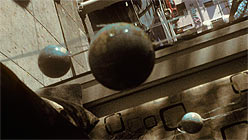“Viewing a film has tremendous mystical implications,” Nathaniel Dorsky writes in his 2003 lecture-cum-monograph Devotional Cinema. “It can be, at its best, a way of approaching and manifesting the ineffable. This respect for the ineffable is an essential aspect of devotion.”
That’s as good an introduction as any to Dorsky’s own work, and a relief, as his are precisely the sort of ephemeral, experimental short subjects for which attempts at written elucidation seem — well, if not futile, then certainly at risk of disrespecting the ineffable. And maybe that’s all you really need to know before going to see the San Francisco artist demonstrate his secular visual liturgy in four installments at the Pacific Film Archive this evening.
Introspective is a word that occurs a lot in conversations about Dorsky, and so it should given his films’ solitude-reinforcing silence, but what about his way, too, of looking so intently out at the world, and at its abundance? What about his prioritization of peripheral mysteries?
By so mindfully observing the undulations of natural and manmade textures that inspire and apparently surround him, Dorsky somehow achieves translucence and opacity at the same time. It’s weird, and beautiful. Sometimes there is the feeling of allowing your eyes to relax their focus, and the enthralling new way of seeing that results. Often there is a feeling of closeness to what’s being seen. It can be intimate.
“If a film fails to take advantage of the self-existing magic of things, if it uses objects merely to mean something,” he writes, “it has thrown away one of its great possibilities.”



